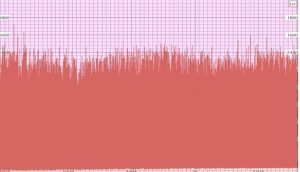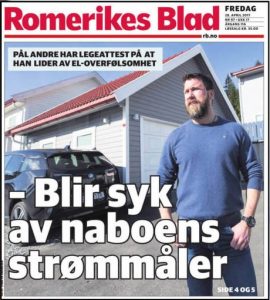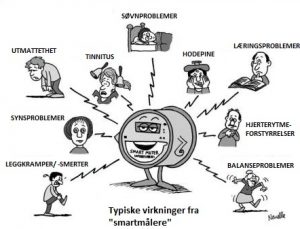(THIS ARTICLE IS MACHINE TRANSLATED by Google from Norwegian)
2,9 million AMS meters – the new smart meters – are being installed in Norwegian homes these days. The authorities have claimed that the meters send far weaker than mobiles, but this was because they have mixed measurement methods: they actually send far stronger2. The Ministry of Petroleum and Energy (OED), the Norwegian Water Resources and Energy Directorate (NVE) and the electricity grid companies have not taken the warnings of harmful biological effects seriously. They are more concerned with keeping progress – everyone should be connected before 20193. Some people report health problems after receiving smart meters in their homes. The meters will inevitably help to pull the number of people with disabilities upwards, with diagnoses beyond a wide range of "unexplained" disorders. This is how we get a taste of the Internet of Things.
 Measurement of adverse effects. In my previous article in Ny Tid (October 2017), a number of biological and technical damage mechanisms by radio wave radiation were mentioned. The mechanisms are known in the literature, but are overlooked by the wireless industry. The industry has developed under the guise of spacious limit values based on the fact that such radiation can only be damaged by heating. That's why it's warming potential you set boundaries. And one still associates the measurement method with the heating capability – as an average over time and space – despite the fact that several thousand research reports document more subtle behaviors that cannot be intercepted in this way, and that wireless causes problems and damage without any measurable heating. Not least are the abrupt, strong and short low-frequency pulses in modern digital communication that are linked to a wide range of biological effects4. Aidon markers of the Aidon brand send such pulses every 0,6 seconds around the clock, even if they only transmit tiny consumption data only occasionally.
Measurement of adverse effects. In my previous article in Ny Tid (October 2017), a number of biological and technical damage mechanisms by radio wave radiation were mentioned. The mechanisms are known in the literature, but are overlooked by the wireless industry. The industry has developed under the guise of spacious limit values based on the fact that such radiation can only be damaged by heating. That's why it's warming potential you set boundaries. And one still associates the measurement method with the heating capability – as an average over time and space – despite the fact that several thousand research reports document more subtle behaviors that cannot be intercepted in this way, and that wireless causes problems and damage without any measurable heating. Not least are the abrupt, strong and short low-frequency pulses in modern digital communication that are linked to a wide range of biological effects4. Aidon markers of the Aidon brand send such pulses every 0,6 seconds around the clock, even if they only transmit tiny consumption data only occasionally.
The ICT industry is four times larger than the pharmaceutical industry and capable of promoting its reality: no health risk.
Similarly, Norwegian health policy is based on the notion that no one can get sick when the average exposure is too weak to heat tissue, and that the AMS meters are therefore harmless. But this is outdated knowledge. Limit values to protect against biological influence must be established on the basis of mechanisms that operate at much weaker exposure than today's radiation limits. Among other things, the low-frequency pulsing must be taken into account5.
Canaries in the mine. Books, blogs and social media around the world now find stories about how people get sick shortly after the smart meter is in the house6. The symptoms are especially headache, tenderness, fatigue, rash, joint pain and tinnitus. The effects vary from person to person, strength and duration as well. Health problems people already have, such as MS, can worsen. The complaints are lost in houses without meters or out in the woods and fields. This is the biological explanation for.
The official opinion of the Norwegian health care system is irrelevant that such reactions must have other causes or are due to imagination and anxiety7. But among those affected there are also people who were not the least bit concerned about such, who have not responded to electromagnetic fields before and who did not even know it was possible. Otherwise there are objective medical tests and blind test methods8.

As a percentage, few people report on health problems after meter installation. Rather, "most people" are more likely to get rid of their diffuse plagues for more conventional reasons. It is therefore natural with large dark figures. Those who report are like "canaries in the mine" – they give us the first warning that everyone is exposed to an environmental impact that will affect more over time.
Like Christmas Eve at the boyfriend. Early in the AMS project, the thoughts were aired about the fear of health problems. But the gauges' signals are well within the current limit values, which were expected to be safe, and are within the technical requirements of the Factories Regulations. Thus, the meters communication was based on wireless. And so many health problems nevertheless.
One may wonder how the management could so safely – and still is allowed – to release the wireless technology when professionals around the world warn9. Radiation protection administrations in countries such as Norway are understaffed and admit that they lack the competence to assess the health effects10. National radiation protection agencies and health ministries therefore become grateful users of ready-made reports from the industry, on which they then base their views. The ICT industry delivers. It is about four times larger than the pharmaceutical industry and capable of promoting its reality image. In this way, it can create a common, beneficial understanding that the health risk is low11. Nkom, the online companies, consultants and the undergrowth of small companies choose to trust the authorities, even though current legislation imposes an independent responsibility on them12.
 The AMS project Catch-22. A very common exception wording was included in Section 4 of the AMS Regulation13. It states that "The grid companies are not obliged to install AMS if (…) b) the installation is to the significant and documentable disadvantage of the end user." Exercising discretion was thus left to the grid companies, however, following guidance from NVE: in the comments to the regulations14 NVE gave the interpretation that "AMS should initially be installed in all measuring points" and that "By 'disadvantage for [end user]' is meant primarily in the health sense." In guideline writing15 it was later made clear that NVE wanted the network companies to take the documentation requirements relatively easily for the time being.
The AMS project Catch-22. A very common exception wording was included in Section 4 of the AMS Regulation13. It states that "The grid companies are not obliged to install AMS if (…) b) the installation is to the significant and documentable disadvantage of the end user." Exercising discretion was thus left to the grid companies, however, following guidance from NVE: in the comments to the regulations14 NVE gave the interpretation that "AMS should initially be installed in all measuring points" and that "By 'disadvantage for [end user]' is meant primarily in the health sense." In guideline writing15 it was later made clear that NVE wanted the network companies to take the documentation requirements relatively easily for the time being.
As of June 2017, close to 1000 exemptions were registered. Later figures are not available, but the number has probably risen sharply. Even before the meter replacements began, both OED, NVE and the network companies received letters, complaints and telephones from people claiming that increased health risk from smart meters is predictable, and heavy and comprehensive scientific documentation was presented. Many people applied for exemption on the basis that research shows that there is a "substantial documentable disadvantage" in the health sense – it must be sufficient for a knowledge-based administration that must even have the Constitution's precautionary section (section 112) as a guideline. But no: Step by step, NVE, with OED's blessing, has made it harder to get relief for health reasons16. The online companies are now rejecting the reason that the customer must have a medical certificate that shows that they already have health problems or anxiety that can be linked to electromagnetic radiation. Customers should acquire this in a country where the dogma that is used in medical education is that it is only through warming that health damage occurs. Some doctors therefore refuse to write testimonials stating that they believe such injury reactions are not possible17.
Some people fall ill shortly after the smart meter is in the house.
That one can apply for exemption is hardly traceable on the electricity companies' websites. If you are exempted, you should know that the neighbor's wireless meter is evenly mounted, even if it is on the wall against your bedroom. NVE does not accept that exemptions are granted to protect neighbors, friends, family or caregivers who do not even belong to the household18.
It is a problem for the AMS project that the technology and the deployment method – which needed to give the project realism – is no longer ethically and health-politically sound. It shows the "canaries" chirping about their plagues, and it shows today's knowledge status.
 NVE took part in the technology selection and launched a project that proved to rest on dubious assumptions. If NVE wants to remove the health risk, NVE must impose cabling in blocks, townhouses and dense buildings, as well as directional antennas here and there. The solutions are shelving19, but such a change would blow up budgets and time frames. Such a change will also put the Norwegian Radiation Protection Authority in a bad light and delay the Elhub project – the project that will give Norway a more dynamic, more efficient and more centralized power market.
NVE took part in the technology selection and launched a project that proved to rest on dubious assumptions. If NVE wants to remove the health risk, NVE must impose cabling in blocks, townhouses and dense buildings, as well as directional antennas here and there. The solutions are shelving19, but such a change would blow up budgets and time frames. Such a change will also put the Norwegian Radiation Protection Authority in a bad light and delay the Elhub project – the project that will give Norway a more dynamic, more efficient and more centralized power market.
The network companies, which chose the technology, are also in a compulsory situation: more customers now turn to groups and want wired solutions. They simply will not accept wireless transmitters in the home broadcasting 24/7/365. The network companies that negotiated the wiring alternative are at high risk – in addition to the financial ones – if they choose to continue today's fixed line.
The regulations require documentation that the radiation is a disadvantage, but NVE requires a medical certificate for electrical hypersensitivity.
Dilemmas with the Internet of Things. Such Catch-22 situations many other agencies and businesses will end up on the road to the "smart community". Some are already there: Some new remote controls send radio pulses all the time. The cable TV company Get broadcasts its Getboxer which turns on WiFi fully when plugged in – whether you ordered WiFi or not. Securitas assembles its Verisure alarm centers, which are constantly beaming about the race with the Getbox. Water meters are mounted which transmit status in one set for reading once a month. Because it is cheap to make, provides little customer support and is allowed.
In fact, there are people today who do not get to hospitals and other public services – they simply cannot withstand the radiation on the premises20. Where should those who fall ill be in the "smart" realm of the Internet of Things, when the baptismal dites around us – our own or others' – are plaguing more and more? Should they have to accept the statement of Guro Grøtterud, section manager in the End User Department of NVE: "The hypersensitive get to stay home!"21 Should they stay there then, along with the neighbors' smart meters?
See also:
Solutions without radiation selected
og
The wireless industry's sunsets?
SOURCE NOTES:
[1] Radiation in the radiofrequency range was classified in 2011 as a "2B possible carcinogen" by the IARC, the WHO's cancer research body. It is now common in environmental medicine to consider EMF (electromagnetic fields) as an environmental toxin in the class of insecticides, industrial emissions, etc. – see e.g. "Diagnosis of environment-triggered multisystem diseases from the point of view of clinical environmental medicine". http://europaem.eu. Translated to Norwegian here: https://einarflydal.com/2016/01/20/miljomedisinfaget-emf-er-en-reell-miljogift/[2] Details are explained here: http://emf-consult.com/emf-info/ams-strommaler/
[3] "An EU directive requires 80 percent roll-out by 2020 in those countries that find that smart meters have a positive effect nationally." (TU.no, 26.3.2014) Such a positive effect is calculated for Norway in an optimistic scenario in accordance with Lewis, D. & Kerr, J. (2014). Not too smart: will SmartMeters be the next Government IT disaster? (IoD Policy Report).
[4] The large EU-funded REFLEX study found a variety of damage in cell cultures from such pulses in microwave radiation, see Adlkofer et al. (2004). Risk Evaluation of Potential Environmental Hazards From Low Frequency Electromagnetic Field Exposure Using Sensitive In Vitro Methods (Final Report). The findings are suitable for human and animal discoveries.
[5] The European Academy of Environmental Medicine guidelines therefore provide different limit values for different types of communication systems due to. pulsing. (DOI 10.1515 / reveh-2016-0011) Danish translation: Igor Belyaev et al: EUROPAEM EMF guidelines 2016 for the prevention, diagnosis and treatment of EMF-related health problems and diseases. https://einarflydal.files.wordpress.com/2017/08/europaem-emf-vejledning-dansk-v3-m-bilag-27072017.pdf
[6] See, e.g. https://einarflydal.com/smartmaler-historier/, http://smartmeterhealth.blogspot.no/, https://stopsmartmeters.com.au/category/share-your-story/, http://emfsafetynetwork.org/smart-meters/smart-meter-health-complaints/
[7] See, inter alia. Alexander, J. et al. (2012). Weak high frequency electromagnetic fields - an assessment of health risk and management practices (FHI Report 2012: 3). Folkehelseinstituttet http://www.fhi.no.
[8] See EUROPAEM EMF Guidelines 2016, footnote 5.
[9] https://einarflydal.com/2017/09/22/forsker-advarselen-mot-5g-pa-norsk/
[10] Letter from the Norwegian Radiation Protection Authority to Steenstrup Stordrange DA. (29.4.2015/XNUMX/XNUMX). Regarding the Radiation Protection's competence regarding health risk in exposure to electromagnetic fields.
[11] See, for example, see https://einarflydal.com/2017/11/16/smartmalerne-helsepremisset-som-forsvant/
[12] ICNIRP's 1998 guidelines, which are Norwegian regulations, place responsibility on employers, in addition to states, to set limit values on the basis of available knowledge themselves. In addition, we have the Product Control Act, the Product Liability Act, the Radiation Protection Regulations, the Pollution Control Act, the neighboring law, the working environment law, the obligation to present a type-approval certificate and to submit declarations of conformity, and the Constitution § 112. All this and more does not impose responsibility on all aspects of the measurement rollout. with employees and customers.
[13] See Regulations on amendments to the Regulations on Measurement, Settlement and Coordinated Conduct in Power Sales and Invoicing of Network Services, § 4-1. Duty to install AMS, https://lovdata.no/dokument/SF/forskrift/2011-06-24-726?q=Forskrift%20om%20endring%20i%20forskrift
[14] The Norwegian Water Resources and Energy Directorate. (2011). Advanced Measurement and Management System (AMS) Summary of consultation statements and final regulatory text. http://publikasjoner.nve.no/dokument/2011/dokument2011_07.pdf
[15] Letter from NVE to the network companies 07.12.2016: https://einarflydal.files.wordpress.com/2017/11/nve-om-dispensasjon-fra-kravet-om-installasjon-av-ams-mc3a5ler-kommentar.pdf
[16] See the latest post and review on it https://einarflydal.com/2017/10/30/ny-nve-beskjed-skift-ut-alle-malerne-og-sett-antennene-der-folk-vil/
[17] See, e.g. http://www.blv.no/nyheter/legene-vil-ikke-blandes-inn-i-strommaler-saka-1.2095034 and commentary http://www.blv.no/nyheter/voksenopplering-om-smarte-malere-1.2107870
[18] https://einarflydal.files.wordpress.com/2017/10/nve-svar-pc3a5-klage-pc3a5-hafslundnett13-06-2017-usladdet.pdf. This decision is also used to refuse the other situations mentioned.
[19] More mention on https://einarflydal.com/2017/10/06/fa-kabel-mellom-smartmalerne-sa-er-problemet-borte/
[20] Some of many Swedish documented cases are found here: Ladberg, Gunilla: A beautiful prison (ISBN 978-91-973438-6-2) and von Hedenberg, Christine: Another World (ISBN 978-91-639-2752-2).
[21] https://einarflydal.com/2017/09/08/nve-de-el-overfolsomme-far-holde-seg-hjemme/


